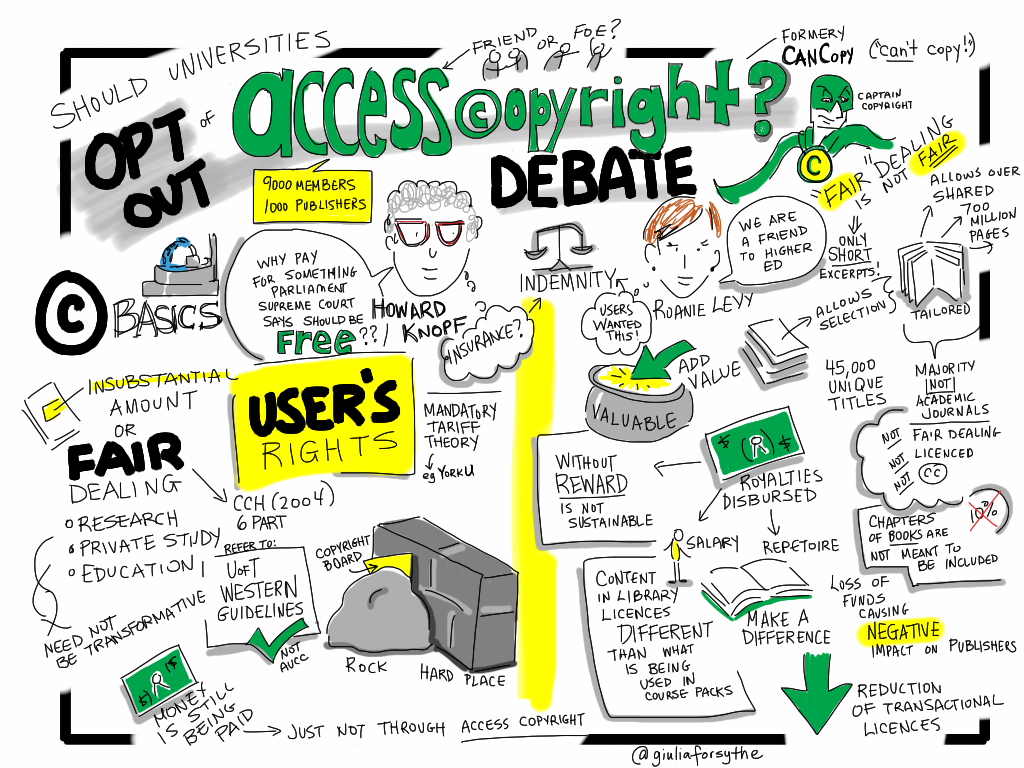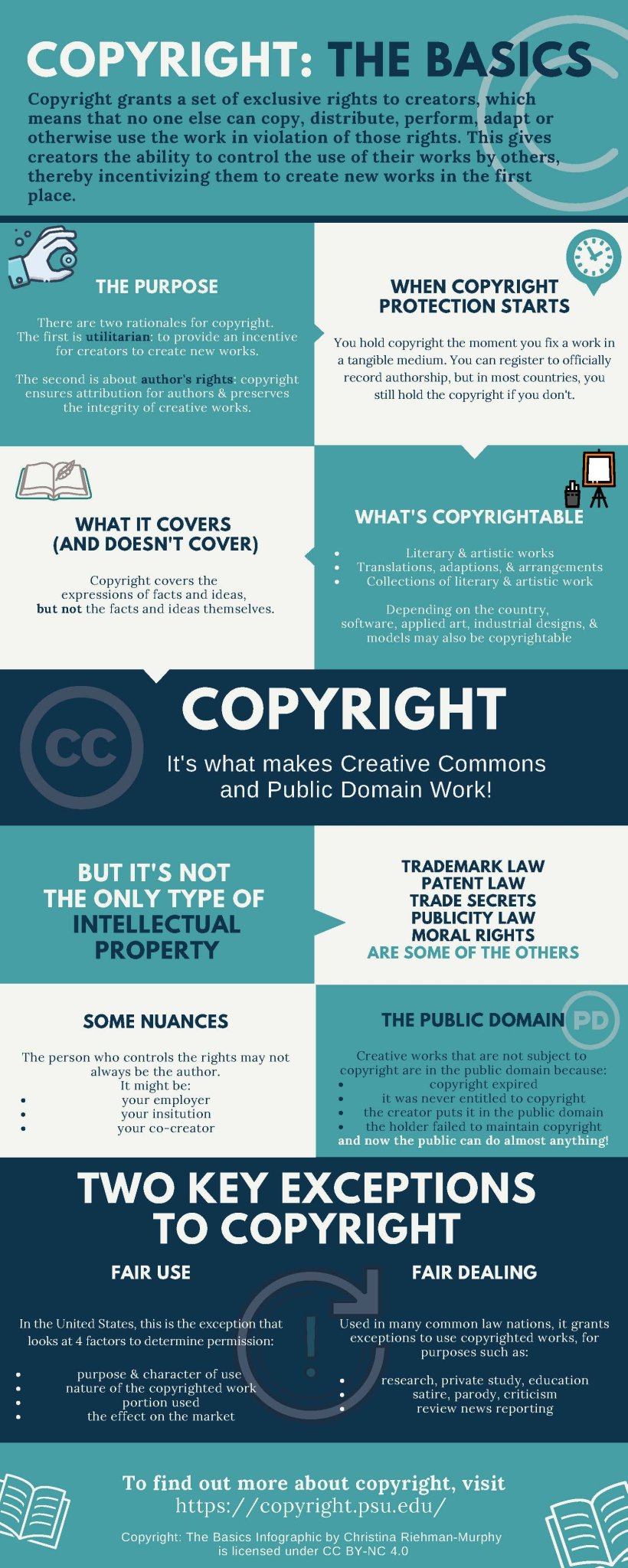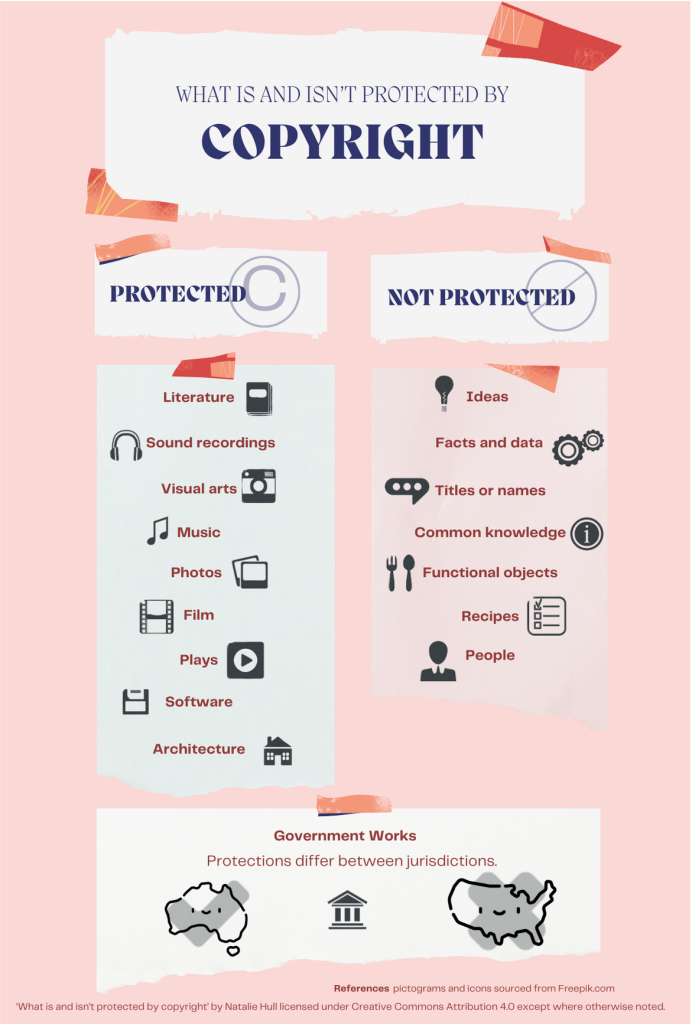Overview of copyright
- Purpose of Copyright
- Copyright Protection
- Copyright Coverage
- Exceptions and limitations to copyright
- Copyright Alternatives
Purpose of copyright
Copyright is a form of intellectual property intended to protect the original expression of ideas and provide creators with exclusive economic rights over material they create. Copyright also provides for the moral rights, meaning the right to attribution and the right against false attribution[1].
The purpose of copyright is to provide creators with the legal protection and exclusive rights to their original works for a limited duration. This protection encourages creative expression and innovation by giving creators the incentive to invest time and resources into the development of their ideas[2].
Copyright serves several important purposes:
- Incentivizing Creativity: Copyright rewards creators by allowing them to control and profit from their works, motivating creators to continue producing new content and ideas.
- Protection of Intellectual Property: Granting creators the exclusive right to reproduce, distribute, and display their work prevents others from profiting from or replicating their creations without permission.
- Economic Benefits: By providing a legal framework to protect investments in creative and innovative works, copyright stimulates economic activity in industries like publishing, entertainment, and technology.
- Promoting Innovation: Protecting technological innovations is crucial for inventors and companies to invest in research and development, knowing that their inventions will be protected for a certain period.
- Cultural and Artistic Enrichment: Copyright ensures that creators can control how their works are used and disseminated, which can lead to the creation of diverse and meaningful cultural content.
- Encouraging Progress: Copyright law includes the concept of “fair use” or “fair dealing,” which allows limited use of copyrighted material for purposes such as criticism, commentary, education, and research, ensuring that knowledge and culture can continue to evolve.
Overall, the purpose of copyright is to strike a balance between incentivising creators to produce new works and ensuring that society benefits from the dissemination of knowledge, culture, and innovation. It accomplishes this by providing legal protection and control over original works while also allowing for exceptions and limitations to ensure access and progress.
Copy (aka copyright) Tells the Story of His Life
#FixCopyright: Copy (aka copyright) Tells the Story of His Life (YouTube, 9m 16s) – a short history of copyright and its relation to creativity and sharing:
Copyright protection
Copyright protection is granted to creators automatically when they create an original work that falls within the scope of copyright law. In most countries there are no formalities required to receive copyright protection[3]. Here’s a general overview of how a person typically receives copyright protection for their work[4]:
- Creation of an original work: Copyright protection begins when a person creates an original work in a fixed and tangible medium.
- Common law vs civil law: In common law countries like Australia and the United States the employer is typically the owner of, and controls, the economic rights of the copyrighted work created by employees within the scope of employment. In many civil law countries, such as France and Germany, copyright typically rests with the employee-author, unless otherwise contracted.
- Students: Rights and protections will depend on jurisdiction, as well as school or university policies, and terms of enrolment at the particular institution.
- Transfer: Exclusive rights granted by copyright can be transferred to others, including legal entities such as corporations, publishers, or universities. Rightsback.org has more information on rights or to figure out who holds those rights.
- International protection: Copyright protection is often governed by international agreements like the Berne Convention, which provides protection in many countries. Creators from one Berne Convention country have their works protected in other member countries without the need for separate registrations.
Copyright coverage
Types of works
Copyright does not protect the idea, information or facts themselves, only the expression of those facts or ideas. Copyright law can be complex and varies by jurisdiction, so it’s advisable to consult with a legal expert. Additionally, digital advancements have introduced new challenges and considerations, such as those related to online content and social media, which have their own copyright implications.
Lessons from fashion’s free culture
Jurisdiction of works
There is no one “international copyright law” and each country has its own standards for what is protected by copyright, how long copyright lasts and what it restricts, and what penalties apply when it is infringed[5].
Two principles underlie the international patchwork of laws and agreements[6]:
- Territoriality: A government has no power to govern activities that fall outside of its borders. Copyright is territorial in nature, it is enacted and enforced through national laws.
- National treatment: A rule of non-discrimination; a country must grant foreign authors no less favorable treatment than it grants its own nationals.
What copyright law applies to my use of works?
Generally speaking, the rule of territoriality applies, meaning the law of the country where a work is used applies to that particular use. If you are travelling in Germany and using a copyrighted work, German copyright law will apply to your use of the work.
Worldwide map of copyright term length, as of June 2019. Author:, Balfour Smith, Canuckguy, Badseed, Martsniez – Original image by Balfour Smith at Duke University. CC BY-SA 3.0
Exceptions and limitations to copyright
Copyright is not absolute[7]. Certain uses known as “exceptions and limitations” do not require permission. Every country has exceptions and limitations within its copyright system, and may include uses for purposes of criticism, parody, access for the visually impaired, and more[8].
Generally speaking, there are two main ways in which exceptions and limitations are written into copyright law; one is by itemising specific activities that are excluded from the reach of copyright; the other is to include more flexible guidelines for courts to determine use[9].
Civil law countries commonly use the approach of itemising limitations, however this can be more limiting of uses of copyright material. Common law tradition includes more flexible guidelines about what is allowed, enabling the law to adapt to new technologies and situations, although leaving more room for uncertainty.
Some of these exceptions to copyright might require economic compensation for these uses, but most do not. As a general guideline, exceptions to copyright are free, while limitations to copyright are subject to payment. A compulsory, statutory licence is considered a limitation, where “fair dealing” is considered an exception[10]. Compulsory licences allow the use of works in certain circumstances without the right owner’s permission but require economic compensation for that use[11].

Should Universities Opt Out of Access Copyright? @HowardKnopf @RoanieLevy Debate #congressh #caljacrs14 by Giulia Forsythe https://flic.kr/p/nvbkJN (CC0 1.0)
Copyright alternatives
Copyright is one of several methods for protecting intellectual property[12]. The choice of protection depends on the nature of the intellectual property, its intended use, and the specific rights and benefits that the creator, inventor, or business seeks to secure. Often, multiple methods of protection may be applied simultaneously to safeguard different aspects of a single intellectual property.
Here’s an overview of the relationships between copyright and other methods of intellectual property protection, also referred to as industrial property[13]:
| Protection | Purpose | Relationship with Copyright |
| Trademark | Protects brands and symbols associated with goods or services | Copyright may protect the artistic elements of trademarks, while trademark protects the brand’s identity |
| Patent | Safeguards inventions, processes, and functional innovations (lasts 20 years) | Copyright is applied automatically, whereas patents require formal application and examination |
| Design patent | Covers the asthetic, non-functional aspects of an object | A design could be protected by both copyright and design patents, but these rights are distinct in purpose and criteria |
| Geographical indications | Protects products associated with a specific geographical origin | Copyright protects creative aspects, whereas geographical indications are about protecting the reputation and quality of products from a specific region |
| Trade secrets | Protects confidential information that is commercially valuable (lasts as long as information remains confidential) | Copyright is a form of public protection for creative works, whereas trade secrets rely on secrecy to maintain their value |
Because all works are automatically granted protection under copyright for the length of the appropriate act, creators who want their works to be available outside the parameters of copyright are required to take action. Creative Commons seeks to resolve the tension between copyright and a creator’s ability to share digital works globally[14]. CC licences can be applied by creators of works to specify the parameters of use allowed without the requirement to seek permission. Creators may still grant explicit permission for uses that fall outside the licence. A Creative Commons licence is not an alternative to copyright, nor does the use of a licence mean that a creator gives up copyright or puts their work in the public domain[15].

‘Copyright: The Basics Infographic’ by Christina Riehman-Murphy is licenced under CC BY-NC 4.0
- https://www.ag.gov.au/rights-and-protections/copyright ↵
- http://www5.austlii.edu.au/au/journals/AltLawJl/2004/31.html ↵
- https://en.wikipedia.org/w/index.php?title=List_of_countries%27_copyright_lengths&oldid=1172414164 ↵
- https://alacc.org.au/requirements-to-gain-copyright-protection/ ↵
- https://en.wikipedia.org/w/index.php?title=List_of_countries%27_copyright_lengths&oldid=1172414164 ↵
- https://certificates.creativecommons.org/cccertedu/chapter/2-2-global-aspects-of-copyright/ ↵
- https://certificates.creativecommons.org/cccertedu/chapter/2-4-exceptions-and-limitations-to-copyright/ ↵
- https://en.wikipedia.org/w/index.php?title=Limitations_and_exceptions_to_copyright&oldid=1180205708 ↵
- https://www.wipo.int/copyright/en/limitations/index.html ↵
- https://certificates.creativecommons.org/cccertedu/chapter/2-4-exceptions-and-limitations-to-copyright/ ↵
- https://www.wipo.int/publications/en/details.jsp?id=4081 ↵
- https://certificates.creativecommons.org/cccertedu/chapter/2-1-copyright-basics/ ↵
- https://www.wipo.int/publications/en/details.jsp?id=4080 ↵
- https://certificates.creativecommons.org/cccertedu/chapter/1-1-the-story-of-creative-commons/ ↵
- https://www.artslaw.com.au/information-sheet/creative-commons/ ↵


